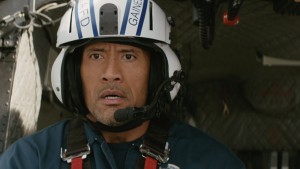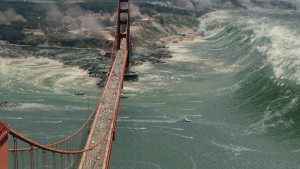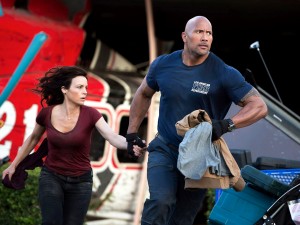
Disaster films are a tricky business. The spectacle of nature wreaking havoc is always eye-catching, but most movies fail to compensate for the epic scale, resorting to a generic story with too many thinly drawn characters. San Andreas definitely falls into this category. The earthquakes and aftershocks are stunning to look at, but the humans suffer with generic interpersonal conflict and drab dialogue that at times approaches self-parody.
Ray (Dwayne Johnson) is an LA Fire Department chopper pilot who struggles deeply with his daughter’s tragic rafting death. Unable to come to grips, Ray’s marriage to Emma (Carla Gugino) has fallen to ruins. When our hero learns that his estranged wife has found a new boyfriend in millionaire developer Daniel (Ioan Gruffudd), he believes all is lost. Until a massive earthquake strikes. Ray leaps into action, desperately attempting to locate Emma and his other daughter Blake (Alexandra Daddario), lost in San Francisco. Do you think Ray will get another chance at romance with his wife, or have an opportunity to make amends for losing a child?
 Well, if you’re ever seen a disaster film before, the answer is obvious. While there are several supporting characters (including a seismologist played by Paul Giamatti, who seems to be in the film solely to deliver exposition), the spotlight is on Ray reconnecting with his family. Actually, that’s not exactly true. Falling prey to genre tropes, the real focus is on depicting devastating destruction across California, brutally offing hundreds of background extras.
Well, if you’re ever seen a disaster film before, the answer is obvious. While there are several supporting characters (including a seismologist played by Paul Giamatti, who seems to be in the film solely to deliver exposition), the spotlight is on Ray reconnecting with his family. Actually, that’s not exactly true. Falling prey to genre tropes, the real focus is on depicting devastating destruction across California, brutally offing hundreds of background extras.
The lead characters are as thinly drawn and ridiculous as they come. As written, boyfriend Daniel’s reaction to the situation is as expected, but is depicted in such an over-the-top manner that it borders on hilarious. As for Johnson, he’s a likable hero, but isn’t given too much to say, with each epic action scene broken up by a steely gaze from our hero and a line like, “I’m just doing my job,” or a patriotic and motivational, “We will rebuild!”
 It’s all very hard to buy into. And that’s about as much story or character development as is written. Admittedly, the digital effects are impressive and fun, as our leads fly helicopters and race past collapsing buildings, or attempt survive a giant tsunami that throws cargo ships into the city to knock over whatever structures haven’t fallen yet. This all looks great, but we never feel any concern or threat towards the main characters.
It’s all very hard to buy into. And that’s about as much story or character development as is written. Admittedly, the digital effects are impressive and fun, as our leads fly helicopters and race past collapsing buildings, or attempt survive a giant tsunami that throws cargo ships into the city to knock over whatever structures haven’t fallen yet. This all looks great, but we never feel any concern or threat towards the main characters.
Every aspect of this story is predictable, with the exception of the odd campy situation inspiring snickers rather than shock and awe. Particularly amusing is Ray’s attempts to navigate the lawless frontier of a post-earthquake Bakersfield, CA. Watch out people, apparently it only takes a few hours for complete chaos to take hold of the streets in that city.
 While daughter Blake character bucks some convention as a young and able female survivor during the crisis, every other aspect of the film is liberally borrowed from disaster pictures of old. Its overpopulated with characters of various social backgrounds, there’s a heroic, sacrificial gesture that results in an incredibly violent end, a romantically estranged relationship that repairs itself amidst the violence, etcetera. Had someone stepped forward early on an belted out a “love theme”, you would swear you were watching a disaster movie from 1974 (I didn’t stay through all of the end credits, so maybe it’s there).
While daughter Blake character bucks some convention as a young and able female survivor during the crisis, every other aspect of the film is liberally borrowed from disaster pictures of old. Its overpopulated with characters of various social backgrounds, there’s a heroic, sacrificial gesture that results in an incredibly violent end, a romantically estranged relationship that repairs itself amidst the violence, etcetera. Had someone stepped forward early on an belted out a “love theme”, you would swear you were watching a disaster movie from 1974 (I didn’t stay through all of the end credits, so maybe it’s there).
To be fair, San Andreas looks slick and is easy enough to watch as it goes down. There are plenty of goofy laughs to be had from this incredibly silly and entirely unbelievable take on an earthquake flick. But shouldn’t a movie like this strive to pitch some curves into the formula and develop characters, instead of simply drawing laughs from its over-the-top approach? One hopes that should the movie spur a new wave of disaster titles, filmmakers try to focus as much on the people as they do on the big effects.


